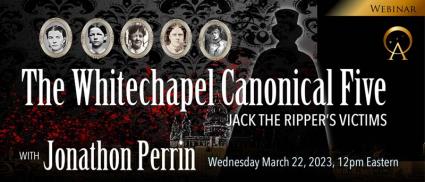
In 1888 Whitechapel and Spitalfields in London were gripped in horror and fear when five women were brutally slaughtered, all within just over two months. Much has been speculated about the identity of the elusive killer dubbed Jack the Ripper, but not so much has been written about the real lives of those women who were the victims of this notorious serial killer.
The so-called “canonical five” victims were Mary Ann Nichols (whose body was found on August 31), Annie Chapman (found September 8), Elizabeth Stride (found September 30), Catherine (Kate) Eddowes (found September 30), and Mary Jane Kelly (found November 9). It has been assumed that all these women were prostitutes, soliciting on the streets of Whitechapel. All, but Mary Jane Kelly, were butchered on the street and Kelly was killed in her room. Curiously, recent research reveals that Nichols, Chapman, and Eddowes were not full-time prostitutes; that Stride had resorted to soliciting only occasionally, during periods of desperate poverty, and that the only verifiable prostitute among the five was Kelly. Were these women also victims of class-based Victorian prejudice and moral self-righteousness?
Mary Ann Nichols, also known as Polly had separated from her husband, with him taking four of their five children. He claimed she had deserted the family and resorted to prostitution, but there was no evidence of this. Polly Nichols’ life circumstances deteriorated, as she had a drinking problem, and she often frequented workhouses. On the night of her death, Polly bragged about her new black velvet bonnet to her lodgings housekeeper. At 2h30 she was seen staggering towards Buck’s Row, and the last time she was seen alive was 05:30 in the morning.
Annie Chapman began her life in relative affluence, and married a private coachman to wealthy families. She was the mother of eight children, but only three survived beyond a few months. It was later realized that she had been drinking during her pregnancies, and her children suffered from foetal alcohol syndrome disorders. After the death of their eldest daughter Emily from meningitis (she was only 12), both Annie and her husband succumbed to alcohol abuse. The couple separated with the husband taking custody of their remaining daughter. Annie paid 8d a night for her double bed in the Dorsett street lodging house. At 1h35 am she was seen walking towards Spitalfields Market…
Long Liz Stride was originally a Swede who located to London in 1866. She was married to a man 22 years her senior and had no children. Her husband passed away and from 1885 until her death Long Liz lived much of the time with local dock labourer Michael Kidney, who resided in Devonshire Street. They would often fight and separate, when Liz would frequent the lodging houses. She earned her lodgings by cleaning the premises.
On 30 September 1888 at 12h35 am ‘Long Liz’ Stride was last seen alive. When her body was found her throat was slit but she was not eviscerated, probably because the killer was disturbed but he moved on that same night to kill Catherine Eddowes.
Catherine Eddowes was described as a very jolly woman, always singing and an "intelligent and scholarly person, but possessed of a fierce temper”. She was last seen alive in a narrow walkway named Church Passage at 1:35 am, an hour after Long Liz was last seen.
Mary Jane Kelly alias Fair Emma, Ginger, Dark Mary and Black Mary, was probably of Irish descent although little is known about her. She found work in a high-class brothel in the more affluent West End of London. She became one of the brothel's most popular girls and spent her earnings on expensive clothing and hiring a carriage. She was last seen alive at 2h35 on 8 November with a man walking towards her lodgings. Mary Jane was murdered within the sparsely furnished single room she rented at 13 Miller's Court, affording her murderer an extensive period of time to eviscerate and mutilate her body.
The inscription upon Mary Jane Kelly's grave marker reads: “In loving memory of Marie Jeanette Kelly. None but the lonely hearts can know my sadness. Love lives forever.”
Author Jonathon Perrin introduces us to each of these unique women, telling the stories of their lives, how they unravelled, and their deaths - all set against the backdrop of East End London during the Victorian Age. It was a horrific period for the lower classes, when judgment ran high, knowledge of addiction was limited and treatment difficult to access, and a bed for the night in a workhouse lodging could be had for 4d – a British fourpence coin, valued at about a third of a shilling.
